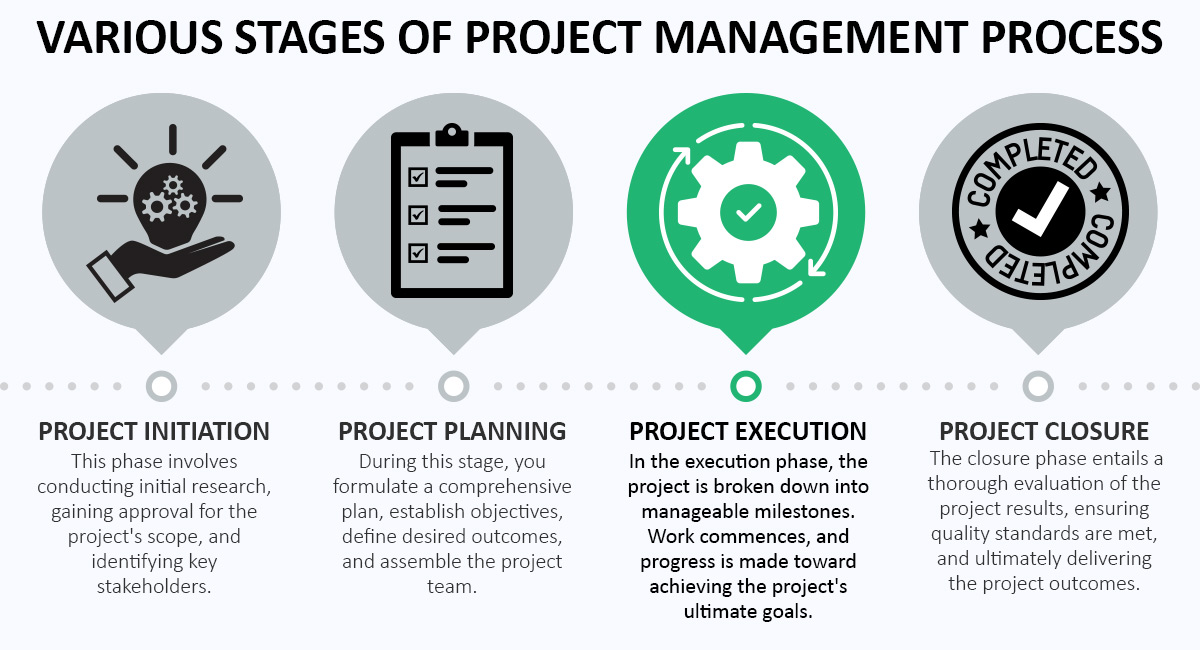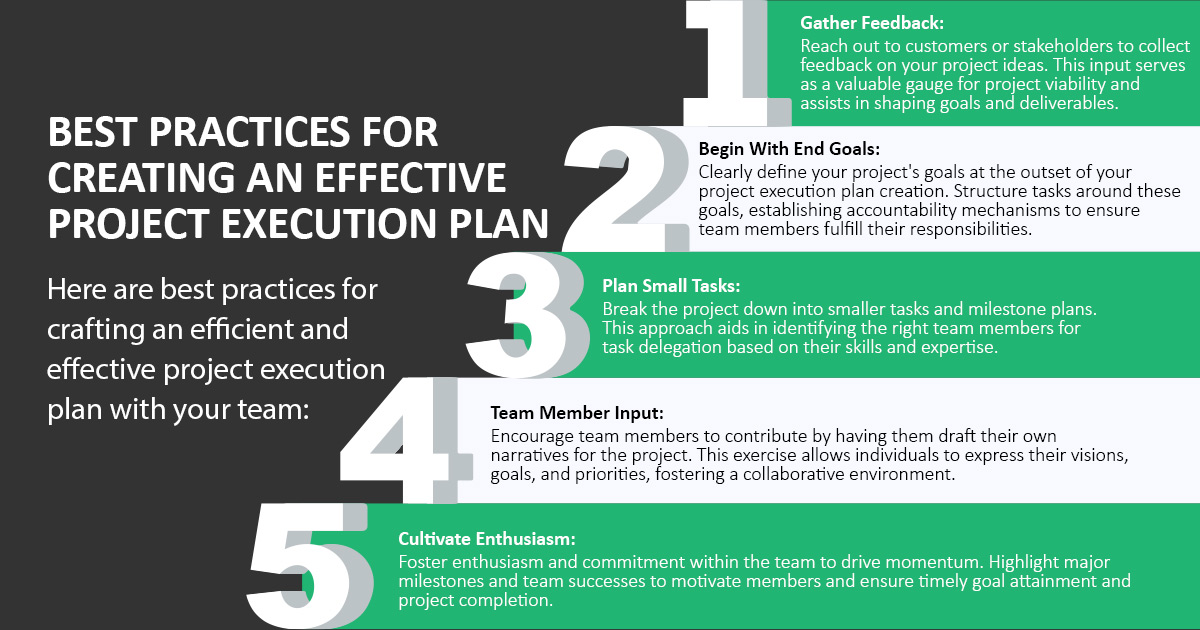
No project is flawless from the start. Creating a brilliant idea is just the starting point; turning it into reality requires a robust project execution plan. However, project execution remains one of the most challenging phases of the project roadmap. The landscape of how work is planned and executed is continually evolving, driven by the ever-accelerating pace of business.
Experts suggest that rather than solely assessing success based on whether a project was delivered on time and within budget, you, the project leaders, must shift your focus towards delivering enhanced business value as your primary goal. Today, modern, adaptive organizations rely on their project management office (PMO) to empower teams and bridge the gap between strategy and the work being delivered. Their emphasis is on delivering project-centric work that strategically benefits the organization.
This shift in focus requires PMOs to acknowledge that the conventional project execution plan is no longer a rigid, unalterable document that teams and project leaders must strictly adhere to. Instead, it functions as a flexible guideline outlining what can be anticipated, with the understanding that the plan may evolve in response to both internal and external factors influencing the project.
To succeed in this evolving landscape, it's essential to learn how to create a project execution plan that not only positions your teams for success but also provides the flexibility needed to accommodate changes that may arise during the project's journey. In this article, we will also discuss how technology solutions such as predictive analytics convert raw data into meaningful insights, making the project execution plan a success.
What Is a Project Execution Plan?
The project execution plan serves as a comprehensive framework for how a project will be executed, monitored, and ultimately delivered. In other words, project execution acts as a bridge between your idea and the team that will make it a reality.
For example, in a project, every action is a task, and these tasks are arranged on a timeline. The timeline specifies planned start and finish dates for each task, along with allocated hours. So, as a project leader, you must identify whether a task is ahead or behind schedule. This helps you keep track of progress, note which department is responsible for each task, and estimate the task's cost. When combined, these elements create a roadmap for your project's execution. However, putting together such a plan might be more challenging than it sounds. It involves turning your theoretical concept into practical steps.
Also, there's more to it than just the basics. After crafting the project execution plan, it's crucial to fulfill milestones, dependencies, and assignments. To ensure timely progress, PMO becomes essential.
The PMO plays a pivotal role in this process by:
- Connecting teams to the bigger picture: PMOs serve as a vital link, aligning the efforts of various teams with the broader organizational objectives.
- Determining the right business outcomes: They are responsible for identifying and prioritizing the most relevant business outcomes to ensure the project's alignment with the overarching strategy.
- Measuring value delivered: PMOs establish mechanisms to gauge and quantify the value generated by the project, ensuring that it aligns with the intended goals.

Remember, project governance needs to be adaptable to swiftly accommodate evolving circumstances. It should allow teams the autonomy to define the methods by which work is delivered while providing necessary guidelines to ensure they remain on course.
When executives alter their strategies or when market dynamics and priorities shift, you will be well-equipped to assist teams in making agile adjustments while keeping them closely aligned with the overarching overall organizational strategy.
Now, you might assume that the project execution planning stage would be the straightforward part of the entire project management process, especially if the challenging groundwork for a successful project has already been laid. Surprisingly, it's during the execution stage that many teams encounter significant challenges.
What Causes Execution Gaps?
The concept of execution gaps in project execution plan might sound intimidating, and rightfully so. Whether you're reflecting on a personal budget that didn't quite pan out (a relatable experience for many) or a team project that seems to be veering off course, the project execution gap, sometimes referred to as a strategy gap, signifies the troubling misalignment between a visionary plan and its real-world implementation.

So, what leads to these execution gaps? There are several potential causes, including overambitious goals and timelines, a lack of clarity regarding the project's vision or objectives, and sometimes a lack of support from key stakeholders.
However, one of the most significant contributors revolves around the project's resources. Resources encompass all the essential elements required to bring the project to its finish line. This can include specific departments or team members, time allocations, and even tangible materials, such as software programs, meeting spaces, and more.
In the project execution planning phase, it's easy to fall into the trap of envisioning them in isolation, as if the project will command everyone's undivided attention for its entire duration. In reality, projects are invariably squeezed in between daily responsibilities and unexpected urgencies, causing resources to become scarcer and more stretched than initially envisioned.
You often find yourself in a competition for, or the need to prioritize, these vital resources, and at times, you may even find yourself waiting for them. Such resource-related bottlenecks not only disrupt the original plan and timeline but, in more unfortunate cases, can lead to the outright failure of your project.
So, how do you overcome these project execution planning challenges? The answer lies in leveraging artificial intelligence-enabled predictive analytics solutions. Let’s look at how modern technology helps you with effective project execution planning.
Utilizing Predictive Analytics for Project Execution Plan
Predictive analytics leverages statistical modeling and historical data to make informed predictions about future performance. Its applications span various industries, including financial services, retail, manufacturing, and health insurance. Surprisingly, the services industry often overlooks discussions about predictive analytics, despite its significant potential impact when employed effectively. Proper utilization of predictive analytics can lead to enhanced cost estimation and budget forecasting, ultimately resulting in improved resource allocation.

Additionally, utilizing predictive analytics for project execution planning offers a range of advantages. This approach involves translating task-level workstreams into comprehensive resource management plans, enabling delivery managers to assess their ability to meet utilization targets, profit margins, and overall performance objectives. Fascinating, isn’t it?
Tips to Create an Effective Project Execution Plan
Kickoff Meeting
Initiate the project with a kickoff meeting, where you communicate the strategy, processes, and actions to the team and stakeholders. Ensure everyone understands the project and is onboard. Share the project execution plan during this meeting to align everyone. AI-enabled predictive intelligence solutions can help you streamline this by onboarding participants, sharing the project execution plan, and assigning tasks efficiently.
Monitor and Control
Throughout the project's execution, maintain control over the schedule, budget, and scope. Keep a watchful eye on potential risks outlined in your risk management plan, and ensure your team's workload remains balanced. Stakeholders can play a vital role in identifying risks early on. Analyze data regularly to track progress, key performance indicators (KPIs), and performance milestones.

Real-Time Data
Real-time solutions assist in project monitoring and enhance collaboration. You can oversee operations, and teams can communicate effectively, whether working in proximity or remotely. Additionally, these solutions also ensure that everyone works with the latest information, enabling more informed decision-making.
Signoff
While delivering project outcomes on time and within budget might seem like the project's conclusion, there are essential post-project tasks. During the project closure phase, obtain sign-offs from stakeholders to verify that the product or service meets their quality standards. Settle payments with vendors and contractors, and release your project team. Don't forget to celebrate this achievement; it not only boosts morale but also acknowledges the hard work of your teams.
Thumb Rules for Project Execution Plan
Creating an effective project execution plan demands a blend of critical and soft skills. These abilities are instrumental in building and nurturing relationships with team members, peers, internal stakeholders, and external stakeholders. To excel in this role and emerge as a strong leader, it is essential to follow these rules:
- Empathy: Cultivate empathy to understand and connect with your team and stakeholders.
- Adaptability and Flexibility: Stay adaptable and flexible to navigate the ever-changing project landscape.
- Thorough Documentation: Document everything meticulously to ensure transparency and clarity.
- Problem Solving: Embrace challenges and think critically when solving problems.
- Clear and Calm Communication: Communicate with clarity and composure, fostering effective collaboration.
- Balanced Taskmaster: Strike a balance between assertiveness and approachability as a leader.
- Beyond Checklists: Don't merely focus on ticking boxes; delve deeper to understand the nuances of the project.
- Goal Orientation: Maintain unwavering focus on the project's objectives to drive success.
By adhering to these principles, you can enhance your effectiveness and lead your teams to successful project outcomes.
What’s Next?
The success of any project is dependent not only on delivering it on time and within budget but also on enhancing business value. You, the project leaders, play a critical role in bridging the gap between strategy and execution, ensuring that projects align with broader organizational objectives. While execution gaps may arise due to ambitious goals, resource constraints, or a lack of clarity, the solution lies in leveraging predictive analytics. If you are looking for one solution that meets all your project execution planning requirements, TrueProject can be your true companion. TrueProject, a predictive intelligence solution for project health and performance, gets information from all your projects' stakeholders in one place, whether internal or external. Furthermore, the solution leverages archived historical project data, findings, and analysis to provide a base repository for benchmarking and trending ongoing projects.
By creating adaptable project execution plans, monitoring progress in real-time, and following key principles such as empathy, adaptability, and clear communication, you can lead your teams to successful outcomes and navigate the challenges of the dynamic project management landscape. Embracing these strategies will not only position your teams for success but also provide the flexibility needed to adapt to changing circumstances, ultimately driving project success and delivering enhanced business value.
More information on TrueProject at www.trueprojectinsight.com.
About the Author:
 www.atlassian.com="" />
www.atlassian.com="" />
Nivedita Gopalakrishna is a content marketing specialist within the TrueProject Marketing team with extensive experience in blog writing and website content creation across diverse industries. Nivedita’s proficiency in crafting engaging blog posts and informative website content is a testament to her years of experience. Beyond her prowess in written communication, Nivedita has the knack for creating visually appealing static graphics that have played a pivotal role in expanding TrueProject's marketing efforts. Through thoughtful design choices, she has helped convey the essence of the brand and captivate audiences effectively. Outside the professional sphere, Nivedita is a trained classical singer and a fitness enthusiast, embodying creativity, and wellness in and out of the office.
Endnotes:
“Become an expert at project execution.” Atlassian, (n.d.).
https://www.atlassian.com/work-management/project-management/project-execution- Parikh, Nidhi. “A Practical Guide to Project Execution.” SmartTask, December 24, 2021 https://www.smarttask.io/blog/project-execution
- Parsons, Angie. “Best Practices for Creating a Project Execution Plan.” Planview, (n.d.). https://www.planview.com/resources/guide/best-practices-of-the-project-execution-phase/best-practices-project-execution-plan/
- Yip, Yolande. “How To Create a Project Execution Plan (PEP) in 6 Steps.” Copilot, May 02, 2023. https://www.copilot.com/blog/project-execution-plan#facilitate-project-planning-and-client-communication
- Landau, Peter. “How to Create a Project Execution Plan (PEP) – Free Template Included.” ProjectManager, January 06, 2022. https://www.projectmanager.com/blog/create-project-execution-plan
- Indeed Editorial Team. “6 Elements of a Project Execution Plan (With Best Practices).” Indeed, June 25, 2022. https://www.indeed.com/career-advice/career-development/execution-plan-elements





